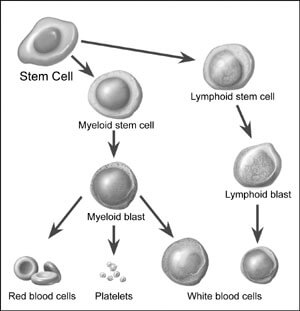Chronic Lymphocytic Leukemia
This page has important information about leukemia,* cancer that starts in blood cells. Each year, leukemia is diagnosed in about 29,000 adults and 2,000 children in the United States.
This discusses possible causes, symptoms, diagnosis, treatment, and follow up care. It also has information to help people with leukemia and their families cope with the disease.
Research is increasing what we know about leukemia. Scientists are studying its causes. They are also finding better ways to treat this disease. Because of research, adults and children with leukemia can look forward to a better quality of life and less chance of dying from the disease.
What Is Leukemia cancer?
Leukemia is a type of cancer. Cancer is a group of many related diseases. All cancers begin in cells, which make up blood and other tissues. Normally, cells grow and divide to form new cells as the body needs them. When cells grow old, they die, and new cells take their place.
Sometimes this orderly process goes wrong. New cells form when the body does not need them, and old cells do not die when they should. Leukemia is cancer that begins in blood cells.
Normal Blood Cells
Blood cells form in the bone marrow. Bone marrow is the soft material in the center of most bones.
Immature blood cells are called stem cells and blasts. Most blood cells mature in the bone marrow and then move into the blood vessels. Blood flowing through the blood vessels and heart is called the peripheral blood.

The bone marrow makes different types of blood cells. Each type has a special function:
 White blood cells help fight infection.
White blood cells help fight infection.
 Red blood cells carry oxygen to tissues throughout the body.
Red blood cells carry oxygen to tissues throughout the body.
 Platelets help form blood clots that control bleeding.
Platelets help form blood clots that control bleeding.
In people with leukemia, the bone marrow produces abnormal white blood cells. The abnormal cells are leukemia cells. At first, leukemia cells function almost normally. In time, they may crowd out normal white blood cells, red blood cells, and platelets. This makes it hard for blood to do its work
Types of LeukemiaThe types of leukemia are grouped by how quickly the disease develops and gets worse. Leukemia is either chronic (gets worse slowly) or acute (gets worse quickly):
- Chronic leukemia — Early in the disease, the abnormal blood cells can still do their work, and people with chronic leukemia may not have any symptoms. Slowly, chronic leukemia gets worse. It causes symptoms as the number of leukemia cells in the blood rises.
- Acute leukemia — The blood cells are very abnormal. They cannot carry out their normal work. The number of abnormal cells increases rapidly. Acute leukemia worsens quickl
The types of leukemia are also grouped by the type of white blood cell that is affected. Leukemia can arise in lymphoid cells or myeloid cells. Leukemia that affects lymphoid cells is called lymphocytic leukemia. Leukemia that affects myeloid cells is called myeloid leukemia or myelogenous leukemia.
There are four common types of leukemia:- Chronic lymphocytic leukemia (chronic lymphoblastic leukemia, CLL) accounts for about 7,000 new cases of leukemia each year. Most often, people diagnosed with the disease are over age 55. It almost never affects children.
- Chronic myeloid leukemia (chronic myelogenous leukemia, CML) accounts for about 4,400 new cases of leukemia each year. It affects mainly adults.
- Acute lymphocytic leukemia (acute lymphoblastic leukemia, ALL) accounts for about 3,800 new cases of leukemia each year. It is the most common type of leukemia in young children. It also affects adults.
- Acute myeloid leukemia (acute myelogenous leukemia, AML) accounts for about 10,600 new cases of leukemia each year. It occurs in both adults and children
No one knows the exact causes of leukemia. Doctors can seldom explain why one person gets this disease and another does not. However, research has shown that people with certain risk factors are more likely than others to develop leukemia. A risk factor is anything that increases a person’s chance of developing a disease.
Studies have found the following risk factors for leukemia:- Very high levels of radiation — People exposed to very high levels of radiation are much more likely than others to develop leukemia. Very high levels of radiation have been caused by atomic bomb explosions (such as those in Japan during World War II) and nuclear power plant accidents (such as the Chernobyl [also called Chornobyl] accident in 1986)
Medical treatment that uses radiation can be another source of high-level exposure. Radiation used for diagnosis, however, exposes people to much lower levels of radiation and is not linked to leukemia.
- Working with certain chemicals — Exposure to high levels of benzene in the workplace can cause leukemia. Benzene is used widely in the chemical industry. Formaldehyde is also used by the chemical industry. Workers exposed to formaldehyde also may be at greater risk of leukemia.
- Chemotherapy — Cancer patients treated with certain cancer-fighting drugs sometimes later develop leukemia. For example, drugs known as alkylating agents are associated with the development of leukemia many years later.
- Down syndrome and certain other genetic diseases — Some diseases caused by abnormal chromosomes may increase the risk of leukemia.
- Human T-cell leukemia virus - I (HTLV-I)—This virus causes a rare type of chronic lymphocytic leukemia known as human T-cell leukemia. However, leukemia does not appear to be contagious.
- Myelodysplastic syndrome — People with this blood disease are at increased risk of developing acute myeloid leukemia
In the past, some studies suggested exposure to electromagnetic fields as another possible risk factor for leukemia. Electromagnetic fields are a type of low-energy radiation that comes from power lines and electric appliances. However, results from recent studies show that the evidence is weak for electromagnetic fields as a risk factor.
Most people who have known risk factors do not get leukemia. On the other hand, many who do get the disease have none of these risk factors. People who think they may be at risk of leukemia should discuss this concern with their doctor. The doctor may suggest ways to reduce the risk and can plan an appropriate schedule for checkups.
SymptomsLike all blood cells, leukemia cells travel through the body. Depending on the number of abnormal cells and where these cells collect, patients with leukemia may have a number of symptoms.
Common symptoms of leukemia may include:- Fevers or night sweats
- Frequent infections
- Feeling weak or tired
- Headache
- Bleeding and bruising easily (bleeding gums, purplish patches in the skin, or tiny red spots under the skin)
- Pain in the bones or joints
- Swelling or discomfort in the abdomen (from an enlarged spleen)
- Swollen lymph nodes, especially in the neck or armpit
- Weight loss
Such symptoms are not sure signs of leukemia. An infection or another problem also could cause these symptoms. Anyone with these symptoms should see a doctor as soon as possible. Only a doctor can diagnose and treat the problem.
In the early stages of chronic leukemia, the leukemia cells function almost normally. Symptoms may not appear for a long time. Doctors often find chronic leukemia during a routine checkup—before there are any symptoms. When symptoms do appear, they generally are mild at first and get worse gradually.
In acute leukemia, symptoms appear and get worse quickly. People with this disease go to their doctor because they feel sick. Other symptoms of acute leukemia are vomiting, confusion, loss of muscle control, and seizures. Leukemia cells also can collect in the testicles and cause swelling. Also, some patients develop sores in the eyes or on the skin. Leukemia also can affect the digestive tract, kidneys, lungs, or other parts of the body.





































